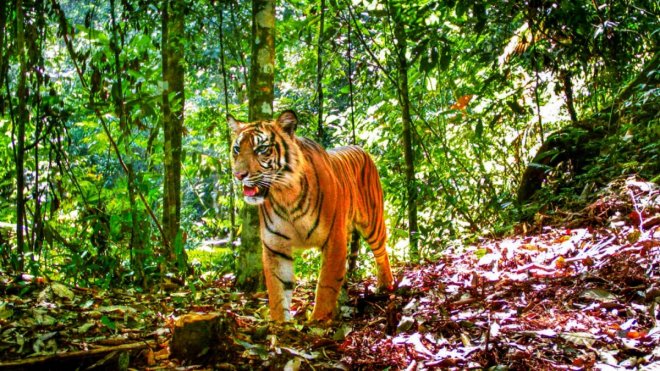
Despite the increase in the population of endangered tigers in the Sumatra Island, continuing deforestation poses threat to the endemic species in the unique island habitat.
The Rainforests in Sumatra which have been listed under Tropical Heritage zone by the UNESCO has been supporting many rare species but the extensive oil palm plantation in Indonesia has been rapidly depleting the forest cover in the Island, said reports.
The island got higher significance with the recent discovery of a new species of Orangutan from its forests. The finding has increased the number of ape species to eight, including the two native Orangutan species of the island.
The Sumatran tigers are one of the largest predators in the Island. As per the report published in the journal Science, researchers of Leibniz Institute for Zoo and Wildlife Research in Berlin said based on specimen from different museums, it has been found that there are only two subspecies of tigers: the Continental tigers and the Sunda tigers.
According to the researchers, the Bengal, Siberian, South China, the Indochinese, Caspian and the Malayan tigers constitute the Continental subspecies while the Sumatra, Bali and Javan tigers constitute the Sunda tigers. The research found that the entire tiger population in Asia and different islands belong to the two subspecies.

The Sumatra tigers are the only existing tiger group among the three Sunda tiger subgroups which were found in the Sumatra, Java, Bali, and Singapore Islands. The Bali and Java tigers are extinct in the 20th Century due to poaching and destruction of their habitat.
According to the researchers, as of 2015, about 4,000 tigers had been living in the wild, mainly due to the efforts taken by the governments of India and Indonesia. According to the report, there are around 2,000 Indian Bengal tigers while the South China tigers are believed to be fully extinct. Experts have estimated that there are currently 400 Sumatran tigers living on the planet.
Ironic but the anti-poaching effort taken up by the Indonesian government has reportedly increased the number of the tiger from highly endangered lists but all the efforts have been found nullified by the loss of habitat that led to loss of prey and eventual extinction of tigers.
The research funded by the National Geographic Society and published on December 5 in the journal Nature Communications says that there has been a decrease of around 17 percent of the forest land in the island between 2000 and 2012. Sumatra has lost the highest amount of its rainforest cover in the world after extensive cultivation of the cash crops, affecting its biodiversity.








